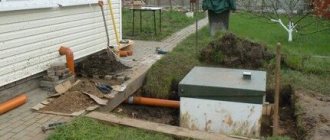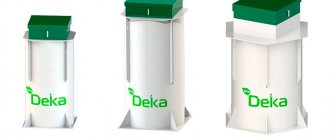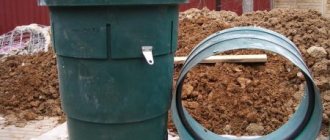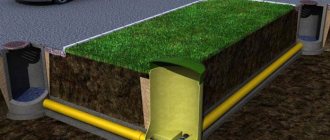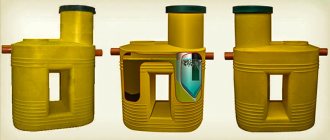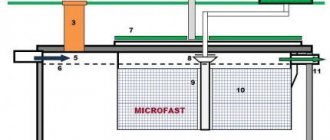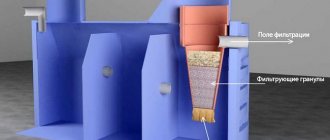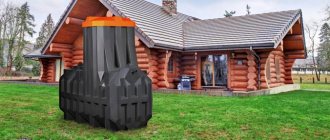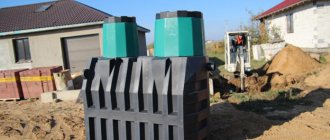The Termit septic tank is an independent sewage system for treating wastewater by settling, filtration and partial decomposition of solid particles by bacteria. These septic tanks are used where there are no centralized drainage systems. The design collects and absorbs contaminants so effectively that purified water can be used for watering beds, flower beds, and also for technical needs.
- 2 Model range
- 3 Advantages and disadvantages of using a Termit septic tank
- 4 Owner reviews
- 5 Installing a Termit septic tank with your own hands
5.1 Required materials, tools and components
- 5.2 Preparatory stage
- 5.3 Installation of a treatment plant
5.3.1 Video: installation of the Termit septic tank
Design and principle of operation of the Termit septic tank
Treatment facilities are manufactured in the Russian Federation. They meet sanitary and construction requirements and do not harm the environment. The work is based on the principles of purification at the mechanical and biological levels. Typically, the Termit has two or three compartments. When passing through them, polluted waters are purified and clarified.
Purification of contaminated waters is carried out at the mechanical and biological levels
The septic tank consists of the following compartments:
- storage chamber - it is used to collect wastewater and its sediment, to settle solid particles;
- bacterial filtration compartment - in this tank, previously clarified waters are additionally purified by bacteria living on special brushes;
- additional sump - this compartment is not available in all variants of Termite. In it, wastewater settles again, and contaminants settle to the bottom in the form of activated sludge.
All tanks are connected to each other by an overflow - a special connecting pipe.
Method of operation of the unit with the simplest cleaning system:
- From the sewer system, pollution flows into the first settling tank, where large and heavy particles settle.
- When the overflow level is reached, they move to the next compartment. The location of the overflow does not allow large contaminants to flow further. They remain in the first chamber.
- In the second compartment, wastewater purification occurs due to the activity of microorganisms, due to which the remaining dirt breaks down into water and nitrites. The liquid rises to the top and is filtered, after which the water can be considered 65 percent purified. Due to the activity of anaerobic bacteria, an unpleasant “aroma” is possible.
- The liquid ends up in the irrigation dome - the infiltrator. After passing through an additional soil filter, the quality of liquid purification is about 95 percent. Water is used for watering a vegetable garden or garden, since it can already be considered safe.
The device does not require electricity to operate. Energy independence is one of the main advantages of Termit cleaning devices.
Models
There is a wide range of Termit cleaning mechanisms, which differ in performance and design dimensions.
Drives
These are sealed containers designed to collect household waste. This type of installation offers the simplest installation and operating principle. Let's look at the types of drives that are available in 6 modifications.
"Termite 2F"
The reservoir of the device consists of 2 chambers, the productivity of which is 700 l/24 hours. The Termit septic tank is designed to serve 2-4 residents. This septic tank has 1 neck, which is used to pump out sludge from the bottom of the container. The system is equipped with 2 fittings, the diameter of one fitting is 11 cm. The weight of the structure is 140 kg, the volume of the container is 2 cubic meters. l. A load of pumicite and a weighting agent is placed in the filter mechanism. The dimensions of the septic tank are 1415x1155x2005 mm.
"Termite 2.5F"
The capacity of the container is 2500 liters, it has 2 chambers, and is designed to serve 3-5 people. Each chamber of the cleaning mechanism is equipped with a neck. The diameter of 1 compartment is 50 cm, through which the sludge is pumped. 2 chamber with a diameter of 65 cm, which is used for special filter maintenance. The productivity of the structure is 1 m3/24 hours. The thickness of the case walls is 20 mm, dimensions are 1820x1155x2005 mm. The weight of the system without a filter mechanism is 120 kg.
"Termite 3F"
Capacious mechanism, the volume of which is 3000 liters. The productivity of the system is 1.4 m3/24 hours, the septic tank can serve 4-6 residents. This type of septic tank consists of 3 chambers, which affects the quality of wastewater treatment. The dimensions of the mechanism are 2210x1155x1905 mm.
"Termite 3.5F"
The three-chamber cleaning mechanism with built-in filter mechanism has a rectangular shape and is equipped with 2 necks with opening lids. The tank volume is 3500 liters, productivity is 1.8 m3/day. This capacity of the tank allows serving 5-7 people. Case dimensions – 2230x1190x2005 mm, structure weight – 175 kg (without filter).
"Termite 5.5F"
The most capacious purification system among the Termit septic tank models, because the tank volume is 5500 liters and the productivity is 2.5 m3/24 hours. A powerful cleaning mechanism is capable of cleaning wastewater from several baths, toilets, and washing machines. It is manufactured to serve 7-11 residents. Capacity parameters: 2220x1650x2395 mm, system weight – 260 kg.
"Termite Pro"
The Termit Pro septic tank is a non-volatile installation structure. It is designed to serve seasonal dacha residents. The disadvantage of installing this design is that the septic tank can operate at low groundwater levels. manufactures such installations in 5 modifications. The lowest-power mechanism is the Termit Profi 1.2, whose productivity is 400 l/24 hours, and can be operated by 1-2 people.
"Transformer S"
This is a series of installations with gravity drainage. The inside of the tank consists of 3 compartments. The overflow from compartment 1 to compartment 2 is equipped with a large-fraction filter mechanism. The second chamber is filled with a polymer filler to create comfortable conditions for the functioning of microorganisms. From chamber 3, the liquid flows by gravity into the sprinkler for soil purification.
"Transformer PR"
The internal arrangement of such units is similar to the treatment facilities of the previous series. They differ only in that the “Transformer PR” model provides for the installation of a drainage pump to pump liquid from chamber 3 to the filtration fields. The pipes of this septic tank have different diameters - 11 cm and 32 cm. The most popular model among users is “Transformer 2”, which can serve 3-4 people, and the productivity of the tank is 800 l/24 hours.
Advantages and disadvantages of using a Termit septic tank
The advantages of the device include:
- autonomy and energy independence;
- strength and resistance to pressure and temperature changes;
- ease of maintenance;
- durability;
- high degree of purity of the output water.
Of the minuses note:
- risk of wall sagging due to the rectangular design;
- possible unpleasant odor. This drawback can be eliminated by purchasing and installing special filters.
How is it arranged?
The production of septic tanks is carried out by Termit, which specializes in the creation of especially large products made of polyethylene. There are 2 brands used to designate products: “Termite” and “Multstock”. The company was organized in 2004, having previously been equipped with a technical base, which determines the quality of the manufactured products. The company produces containers on its own equipment, the volume of which ranges from 10 to 10,000 liters.
The Termit septic tank is a rectangular tank consisting of 2 or 3 chambers. In each chamber, wastewater is purified in stages. The waste liquid passes through these compartments, being cleaned and clarified by bacteria living in the container. Microorganisms perform the breakdown of organic substances found in wastewater. The top of the device is equipped with openings for technical maintenance.
Horizontal compilation is the most practical to use. A suburban area does not always have a large amount of free space; the only correct solution for this problem would be to install a horizontal compilation.
The body of the treatment facility is made of cast material with a ribbed surface and no seams. Seamless design eliminates the possibility of system rupture under the influence of various loads. The wall thickness is 15 mm. The ribbed surface is necessary in order to protect the system from soil pressure and groundwater. The height of the ribs is 80 mm, thickness – 20 mm.
The main elements of this design are:
- storage tank – initial cleaning chamber;
- microbial filter in the form of synthetic threads on which colonies of bacteria have settled;
- plastic vessel with filter media.
The housing of the filter mechanism is made in a dismountable manner, which allows you to dismantle and wash the structure yourself. If necessary, modifications to the system can be made.
Owner reviews
It is easier to evaluate the positive and negative aspects of any device based on the reviews of those who have already experienced its operation.
I installed a Termit-Profi 2.5 septic tank. Due to the uneven thickness of the walls, it was necessary to install a stiffening frame so that the installation would not be crushed by the ground. He has no complaints about his work. It has been standing for more than 12 months, the sediment has not yet been pumped out.
Vladimir
https://otepleivode.ru/kanalizatsiya/septiki/septik-termit.html#pr6
At my dacha, the groundwater is so close to the surface that it’s impossible to dig even a simple hole. Therefore, it took me a long time to select a suitable septic tank. The choice was made on “Termite-3”, with the installation of an intermediate well and a pump for pumping water from it into the infiltrator. Of course, I had a chance to work. The infiltrator covered it with soil and planted grass. A green hill has emerged and looks beautiful from the outside.
Sergey
https://otepleivode.ru/kanalizatsiya/septiki/septik-termit.html#pr6
I want to thank . The treatment plant was installed two years ago. There were no problems with it the entire time. We live at the dacha seasonally, and they installed Termit 1.2 with a connection to the house, and it still works without any complaints.
Stanislav Vasilievich
https://srbu.ru/septiki/1373-septik-termit-otzyvy.html
Our family had the first time with independent sewer systems three years ago: there was a need for an urgent installation of a septic tank for my mother-in-law. We bought Termit-Profi 1.2. Four days later it was delivered to us and installation began immediately. There were no comments on the work, a year later they pumped it out. As a result, we are thinking about installing the same one at our dacha. By the way, there was no smell, either before or after installation.
Alexey Viktorovich
https://srbu.ru/septiki/1373-septik-termit-otzyvy.html
We installed a five-cubic-meter Termit storage tank. They anchored it to a concrete slab, sprinkled a mixture of sand and cement on half of the container, and the remaining part was filled with concrete to strengthen it against being pressed down by the earth. Nine months after pumping out, the container began to crack. In the area, groundwater is at a level of 1.20 m, and the tightness has been lost.
Guest
https://srbu.ru/septiki/1373-septik-termit-otzyvy.html
The lineup
Manufacturers offer septic tanks in several versions:
- the most compact model holds only 1.2 cubic meters of liquid, its daily capacity is 350 liters. This option is suitable for a property with accommodation of no more than two people;
- the next model in the line holds 1500 liters; it purifies 500 liters of liquid per day, which is enough to serve 2-3 people;
- the model, designated as 2F, holds 2 cubic meters of waste, it processes up to 700 liters of liquid, and is suitable for serving 3-4 people;
- model 3F is designed to serve 5-6 people, its total capacity is 3000 liters;
- The productive 5F model can easily serve a facility with 7-11 residents; the model holds 5.5 cubic meters of liquid and purifies 2.4 m³ of water per day.
Design
A special feature of the Multiplast Termite septic tank for the home is its unique seamless design. In most cases, plastic containers are produced by welding individual parts together using heat. Thermite is initially poured out in a single tank. To increase rigidity, ribs are used, which make the structure durable and resistant to mechanical and physical stress.
Photo - design
Like Tank and Triton, Termite is an example of an all-in system. It is a solid container divided into several sections. In each of them, liquid is purified:
- Storage tank. Primary gravitational cleaning occurs in it. Here, solid particles fall to the bottom of the tank through the influence of gravity;
- Bacterial filter. Here, cleaning is carried out with special brushes containing colonies of bacteria.
The last section is also supplemented with a granular filter, so Triton’s work is more effective than that of similar bioseptics.
Photo - storage tank
The local septic tank comes in the following versions:
- Termite 1 m3;
- 2 m3;
- 3 m3.
The 1 m3 model has small dimensions, so it is popular among those with a small yard. The capacity is enough to purify water for a family of up to 3 people. You can connect a washing machine, a shower stall, toilet outlets and two sinks to it.
Photo filters in a single-cube system
The two-cube system is designed for use by a family of up to 4 adults and two children. It has a larger number of outlets for toilets, four sinks and a shower cabin with a bathtub and additionally for a washing machine and dishwasher.
3 m3 is rarely used to service one residential building. Firstly, its volume has been increased to 300 cubic meters, and secondly, its price is significantly higher than that of previous models. In addition to the standard number of water consumers, several bathtubs and a Jacuzzi can be connected to it.
Features of operation
The maintenance procedure involves cleaning the receiving compartment from accumulated sediment. After 100% pumping of the device using a sewer truck, the device’s reservoir is filled with water. To ensure that such a need arises rarely, you need to:
- use anaerobic microorganisms;
- choose a cleaning mechanism of sufficient productivity;
- Stir the supergranules of the filter mechanism from time to time.
Timely special maintenance of the cleaning system will extend the service life of the device and reduce the need to turn to vacuum cleaners for help.
What is prohibited from being discharged into the cleaning system:
- building mixtures;
- paints and varnishes and household chemicals (paint, varnish, alcohol, solvent);
- petroleum products: gasoline, diesel fuel, antifreeze;
- large food waste: vegetables, fruits;
- medications;
- liquid that is drained after filtering the pool, since it contains an increased amount of reagents.
It is allowed to drain wastewater that comes from the kitchen (sink), bathroom (toilet), and bathroom (bathtub, washing machine) into the treatment station. If you follow these simple rules, the Termit septic tank will last even longer than the stated 50 years.
For more information on how to install a septic tank, see the following video.
Installation
Let's figure out how to install a Termite septic tank. The type of wiring diagram is selected depending on local conditions. Possible options:
in soils that absorb water well, it is recommended to install one or more (the number depends on the performance of the model) irrigation domes - infiltrators. In addition, under these conditions, it is possible to construct filtration fields with the laying of drainage pipes into prepared ditches filled with crushed stone and sand;
- with low-lying groundwater and well-absorbing soils, it is advisable to build a filter well;
- At high groundwater levels, a complex scheme is used with an intermediate storage well, an above-ground irrigation dome and forced drainage of purified water.
Procedure
When performing installation yourself, you must adhere to the following procedure:
- prepare a pit, and the dimensions of the pit should be approximately 20 cm larger than the dimensions of the body (in length and width);
- sand must be poured onto the bottom of the prepared pit, the layer should be 20 cm high. The sand is spilled with water and compacted with a tamper;
- the model is installed, pipes are connected to it, the connections must be sealed;
- the pit is backfilled; to perform this work, clean sand is used, to which a fifth of cement is added;
- infiltrators are installed about a meter from the septic tank;
- work is being carried out to insulate the upper part of the septic tank and irrigation domes.
Installation features for different soils
Installation of a Termit septic tank can be done in various ways, depending on the type of soil on the site:
Soil with normal water absorption
In this case, a system of drainage pipes is connected to the outlet of the Termit septic tank, through which water is absorbed into the soil. An irrigation dome can also be used. Its capacity depends on the performance of the septic tank.
Septic tank Termite with irrigation dome
Sandy soil
This soil absorbs moisture well, so any type of drainage is suitable. If the groundwater in the area is deep, more than 1.5 m, then a drainage well can be installed at the outlet of the purifier.
Septic tank Termite with drainage well
High groundwater level
If the groundwater level is high, an intermediate drainage well is used with the connection of a drainage pump and a check valve. Water from the well is pumped into an irrigation dome or onto the ground surface.
Constantly high groundwater levels
A drainage well is used, from which water is pumped into the irrigation dome. The dome is placed on the surface of the ground and additionally insulated with an earthen layer.
Installation of a septic tank with a high groundwater level
Clay soil
After the septic tank, a filtration field is constructed, consisting of several layers of crushed stone and sand. The water first passes through the filtration field and then enters the drainage well. From there it goes into the ground or is taken for household needs.
